
WHAT TO DO WITH FENNEL
05/15/20 — Ada Broussard
You know what to do with carrots, and even your kids are fans of kale. But, fennel? For those of you new to this frilly frond, let us take a moment to orient you. Once you learn how versatile fennel is, you’ll be able to incorporate it into your weekly meals and consider the vegetable an ally that you’re excited about instead of a bulb that you dread.
![]() Fennily! A post all about fennel. Photo by Scott David Gordon.
Fennily! A post all about fennel. Photo by Scott David Gordon.
All parts of the fennel plant, root to stem to flower, are edible. The fennel that ends up in your CSA box or market haul has three main components, all delicious: bulb, stalks, and feathery fronds. Fennel is related to parsley (and carrot) family, and like the herb, adding fennel to any dish, raw or cooked, will help brighten up the dish and give it a fresh, herby flavor. When raw, fennel has a slightly anise flavor. And for all the licorice haters out there, you may think that your relationship with fennel stops at this sentence. But when cooked, fennel’s flavor mellows out, sweetens, and softens. Fennel is a common ingredient in Italian and French food, and when sauteed with onions, garlic, and maybe peppers or celery, fennel turns sweet and silky, adding to a flavor foundation worth building upon.
![]() Dill, parsley, and carrots are all cousins to the famed fennel. Use fennel fronds as a substitution for dill when they adorn your CSA box. Photo of dill by Scott David Gordon.
Dill, parsley, and carrots are all cousins to the famed fennel. Use fennel fronds as a substitution for dill when they adorn your CSA box. Photo of dill by Scott David Gordon.
Here at JBG, fennel makes its appearance in early fall, then takes a break during the coldest days, and makes a second and short debut in the spring, before temperature topple 100. In the cooler fall and winter months, fennel works beautifully with Texas citrus like grapefruit and blood oranges, and in the spring, fennel provides the refreshing crunch you need to brighten up a roasted beet salad, a placeholder for cucumbers and basil, both, before they make their debut.
![]() Now that's a bulb! Photo by Scott David Gordon.
Now that's a bulb! Photo by Scott David Gordon.
Raw: To enjoy fennel raw, slice the bulb very thinly using a sharp knife or mandolin. If you’re not using the sliced fennel right away, store it in the fridge in a closed container, submerged in water (with a squeeze of lemon). This will help keep the fennel crispy and crunchy. Shaved fennel is a wonderful anchor to any shaved salad or slaw. Add thinly sliced cabbage, radishes, and fresh herbs for a riff on coleslaw. Or, slice sweet bell peppers and cucumbers, and add shaved fennel and a creamy dressing for another take. Roasted beets, fennel, avocado, and sliced grapefruit is a surprisingly classic flavor combo. If you’re new to eating fennel this way, the trick really is in the slicing. It’s got to be thin. Sprinkle raw fennel fronds on top of anything as a replacement for fresh dill, parsley, or cilantro when it’s all you’ve got. If you’re lucky enough to get your hands on some fennel flowers, these too make wonderful, grassy garnishes.
![]() A simple shaved fennel salad, with root vegetables and a simple dressing. Photo and recipe by Mackenzie Smith.
A simple shaved fennel salad, with root vegetables and a simple dressing. Photo and recipe by Mackenzie Smith.
![]() The moment when fennel, zucchini, and tomatoes are available at the same time is brief. Don't dally to make this salad. Recipe and photo by Summer Migoni.
The moment when fennel, zucchini, and tomatoes are available at the same time is brief. Don't dally to make this salad. Recipe and photo by Summer Migoni.
Cooked: Cooked fennel (and cheese and good olive oil) may just be the secret ingredient that makes Italian food so addictive. Dice fennel bulbs and statue with onions and garlic the next time you’re making a soup or braise, or quarter the whole bulb and simply roast with a tray of whatever root veggies need some attention. Serve roasted fennel on its own, or while warm from the oven, toss with a simple vinaigrette to adorn a salad. Or, maybe you’ll cut the bulb into thin strings, like a half-moon onion, and add it to your next stir fry or fajita spread. We know that dicing the oddly folded bulb may not be as intuitive to an onion. Here is a pretty good youtube video explaining an easy way to do the deed. One of the best parts about slowly cooked fennel is how silky and soft the caramelized vegetable becomes. Given time, it will practically melt into whatever you're cooking, hiding its rich flavor into something that simply tastes deep, warm, and sweet. In other words, don’t worry too much about how you dice the veggie. Removing the tough core is a good idea, but even this part is technically edible.
![]()
Fancy Fronds: Fennel fronds should be treated just like any other fresh herb. Finely dice them to top cooked dishes or salads, or puree them up into your next batch of pesto or pistou. Here in the JBG office, we use our french press and make pots of fennel tea, lightly sweetened with honey (and mint, if it’s around) to add some variation to drinking plain water, all day. We even have a recipe for refreshing and iced fennel frond tea from the JBG archives.
![]() Fennel frond iced tea is a wonderful way to use the filly leaves. Photo and recipe by Mackenzie Smith.
Fennel frond iced tea is a wonderful way to use the filly leaves. Photo and recipe by Mackenzie Smith.
![]() Fennel look so stately growing out of the ground. Beneath the bulb is a large taproot, holding the stately plant upright. Photo by Scott David Gordon.
Fennel look so stately growing out of the ground. Beneath the bulb is a large taproot, holding the stately plant upright. Photo by Scott David Gordon.
A note on Fennel stems: Fennel stems may be the most overlooked portion of this plant. Use the fennel stems of very young and small fennel as a replacement for celery. Add very finely chopped fennel stalks (and bulbs, for that matter) the next time you’re prepping a mirepoix or sofrito. Once the stalks become big and thick, they are less tender and can be used simply to flavor soups, tossing the whole stem and then removing before you're ready to eat. Or, lay tough fennel stalks that have been sliced lengthwise at the bottom of any braises or pans of baked chicken. When in doubt, save fennel for your next batch of stock. But whatever you do, don’t leave fennel out of the fun. You’ll be a fennel fanatic before you know it, and you can thank us later.
![]() All lined up, ready for duty. Photo by Scott David Gordon
All lined up, ready for duty. Photo by Scott David Gordon
Fennel, Carrot, and Rutabaga Salad
Fennel and Sweet Potato Risotto
Fennel and Zucchini salad with citrus vinaigrette
Fennel Tea with Mint and Honey
Roasted fennel Toast
Curried fennel and cauliflower Soup
Sweet Potato Thyme Soup
Fennel Mac and Cheese
Fennel Saurkarut
![]() Fennel mac and cheese is never a bad idea. Photo and recipe by Megan Winfrey.
Fennel mac and cheese is never a bad idea. Photo and recipe by Megan Winfrey.
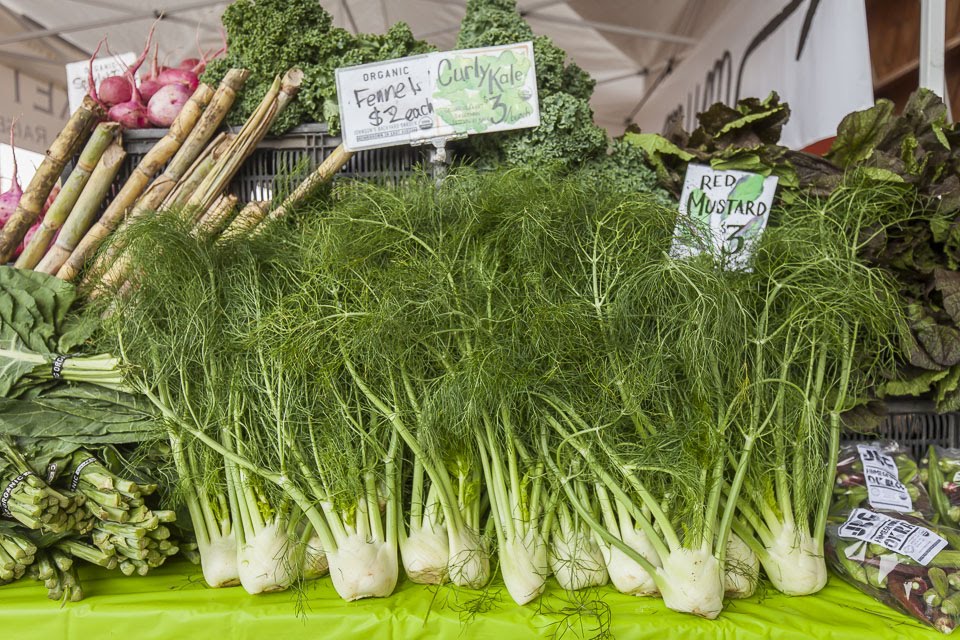 Fennily! A post all about fennel. Photo by Scott David Gordon.
Fennily! A post all about fennel. Photo by Scott David Gordon.
All parts of the fennel plant, root to stem to flower, are edible. The fennel that ends up in your CSA box or market haul has three main components, all delicious: bulb, stalks, and feathery fronds. Fennel is related to parsley (and carrot) family, and like the herb, adding fennel to any dish, raw or cooked, will help brighten up the dish and give it a fresh, herby flavor. When raw, fennel has a slightly anise flavor. And for all the licorice haters out there, you may think that your relationship with fennel stops at this sentence. But when cooked, fennel’s flavor mellows out, sweetens, and softens. Fennel is a common ingredient in Italian and French food, and when sauteed with onions, garlic, and maybe peppers or celery, fennel turns sweet and silky, adding to a flavor foundation worth building upon.
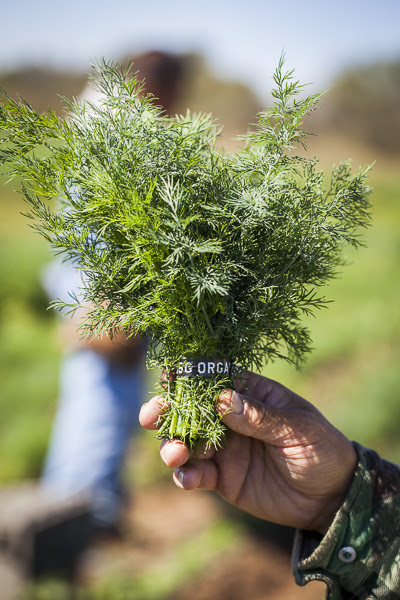 Dill, parsley, and carrots are all cousins to the famed fennel. Use fennel fronds as a substitution for dill when they adorn your CSA box. Photo of dill by Scott David Gordon.
Dill, parsley, and carrots are all cousins to the famed fennel. Use fennel fronds as a substitution for dill when they adorn your CSA box. Photo of dill by Scott David Gordon.
Here at JBG, fennel makes its appearance in early fall, then takes a break during the coldest days, and makes a second and short debut in the spring, before temperature topple 100. In the cooler fall and winter months, fennel works beautifully with Texas citrus like grapefruit and blood oranges, and in the spring, fennel provides the refreshing crunch you need to brighten up a roasted beet salad, a placeholder for cucumbers and basil, both, before they make their debut.
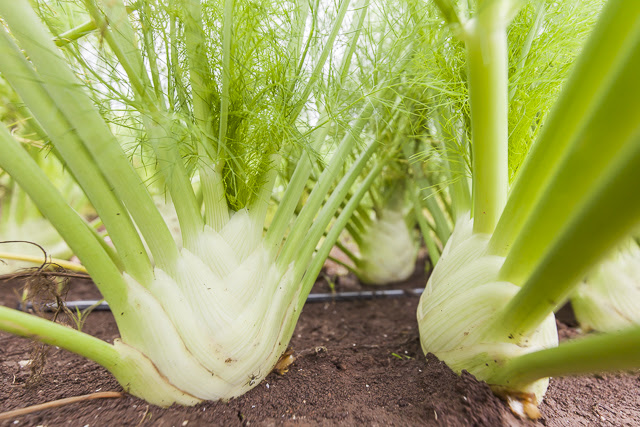 Now that's a bulb! Photo by Scott David Gordon.
Now that's a bulb! Photo by Scott David Gordon.
Raw: To enjoy fennel raw, slice the bulb very thinly using a sharp knife or mandolin. If you’re not using the sliced fennel right away, store it in the fridge in a closed container, submerged in water (with a squeeze of lemon). This will help keep the fennel crispy and crunchy. Shaved fennel is a wonderful anchor to any shaved salad or slaw. Add thinly sliced cabbage, radishes, and fresh herbs for a riff on coleslaw. Or, slice sweet bell peppers and cucumbers, and add shaved fennel and a creamy dressing for another take. Roasted beets, fennel, avocado, and sliced grapefruit is a surprisingly classic flavor combo. If you’re new to eating fennel this way, the trick really is in the slicing. It’s got to be thin. Sprinkle raw fennel fronds on top of anything as a replacement for fresh dill, parsley, or cilantro when it’s all you’ve got. If you’re lucky enough to get your hands on some fennel flowers, these too make wonderful, grassy garnishes.
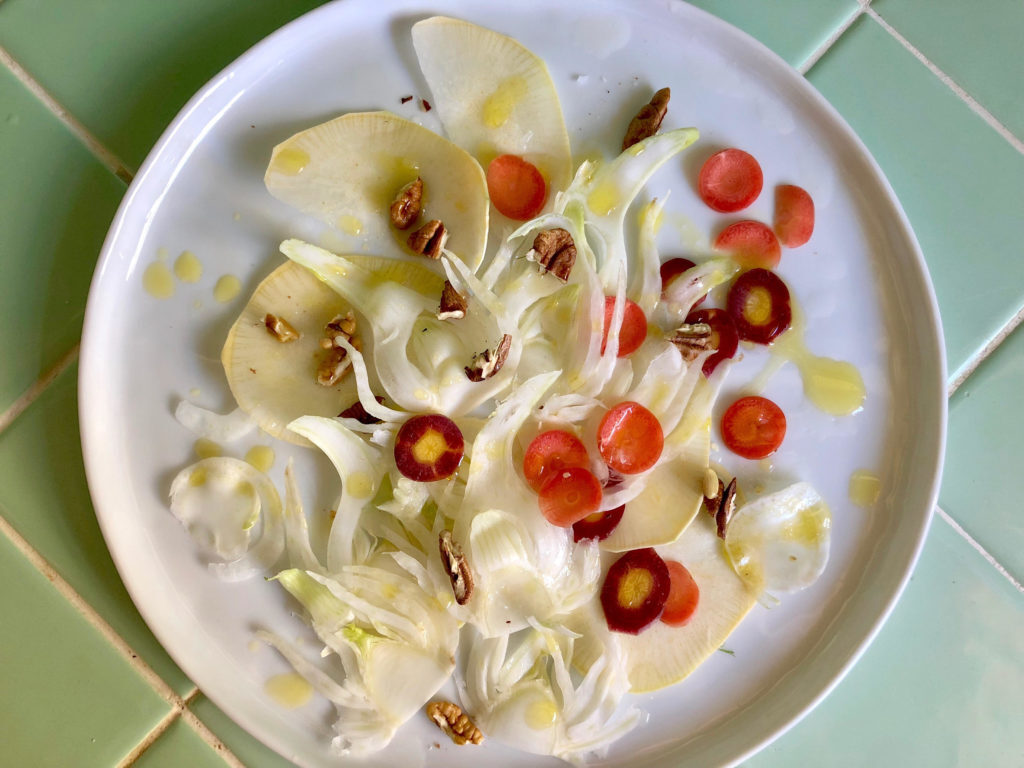 A simple shaved fennel salad, with root vegetables and a simple dressing. Photo and recipe by Mackenzie Smith.
A simple shaved fennel salad, with root vegetables and a simple dressing. Photo and recipe by Mackenzie Smith.
 The moment when fennel, zucchini, and tomatoes are available at the same time is brief. Don't dally to make this salad. Recipe and photo by Summer Migoni.
The moment when fennel, zucchini, and tomatoes are available at the same time is brief. Don't dally to make this salad. Recipe and photo by Summer Migoni.
Cooked: Cooked fennel (and cheese and good olive oil) may just be the secret ingredient that makes Italian food so addictive. Dice fennel bulbs and statue with onions and garlic the next time you’re making a soup or braise, or quarter the whole bulb and simply roast with a tray of whatever root veggies need some attention. Serve roasted fennel on its own, or while warm from the oven, toss with a simple vinaigrette to adorn a salad. Or, maybe you’ll cut the bulb into thin strings, like a half-moon onion, and add it to your next stir fry or fajita spread. We know that dicing the oddly folded bulb may not be as intuitive to an onion. Here is a pretty good youtube video explaining an easy way to do the deed. One of the best parts about slowly cooked fennel is how silky and soft the caramelized vegetable becomes. Given time, it will practically melt into whatever you're cooking, hiding its rich flavor into something that simply tastes deep, warm, and sweet. In other words, don’t worry too much about how you dice the veggie. Removing the tough core is a good idea, but even this part is technically edible.
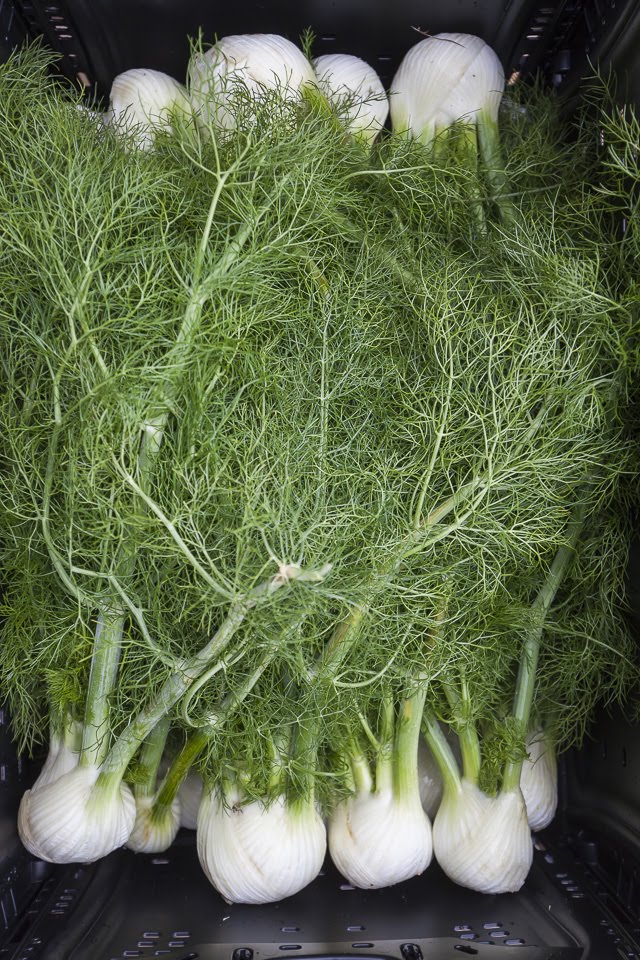
Fancy Fronds: Fennel fronds should be treated just like any other fresh herb. Finely dice them to top cooked dishes or salads, or puree them up into your next batch of pesto or pistou. Here in the JBG office, we use our french press and make pots of fennel tea, lightly sweetened with honey (and mint, if it’s around) to add some variation to drinking plain water, all day. We even have a recipe for refreshing and iced fennel frond tea from the JBG archives.
 Fennel frond iced tea is a wonderful way to use the filly leaves. Photo and recipe by Mackenzie Smith.
Fennel frond iced tea is a wonderful way to use the filly leaves. Photo and recipe by Mackenzie Smith.
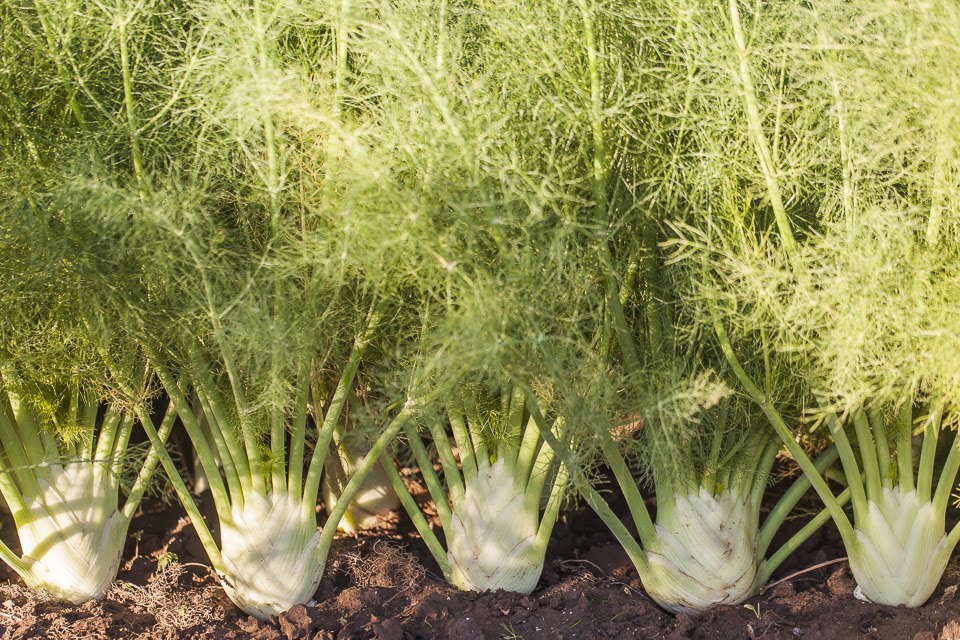 Fennel look so stately growing out of the ground. Beneath the bulb is a large taproot, holding the stately plant upright. Photo by Scott David Gordon.
Fennel look so stately growing out of the ground. Beneath the bulb is a large taproot, holding the stately plant upright. Photo by Scott David Gordon.
A note on Fennel stems: Fennel stems may be the most overlooked portion of this plant. Use the fennel stems of very young and small fennel as a replacement for celery. Add very finely chopped fennel stalks (and bulbs, for that matter) the next time you’re prepping a mirepoix or sofrito. Once the stalks become big and thick, they are less tender and can be used simply to flavor soups, tossing the whole stem and then removing before you're ready to eat. Or, lay tough fennel stalks that have been sliced lengthwise at the bottom of any braises or pans of baked chicken. When in doubt, save fennel for your next batch of stock. But whatever you do, don’t leave fennel out of the fun. You’ll be a fennel fanatic before you know it, and you can thank us later.
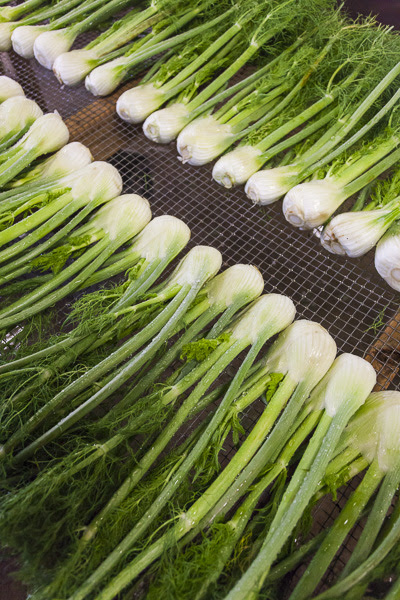 All lined up, ready for duty. Photo by Scott David Gordon
All lined up, ready for duty. Photo by Scott David Gordon
Fennel Recipes from the JBG Archive:
Wilted Kale, Bacon, and Fennel SaladFennel, Carrot, and Rutabaga Salad
Fennel and Sweet Potato Risotto
Fennel and Zucchini salad with citrus vinaigrette
Fennel Tea with Mint and Honey
Roasted fennel Toast
Curried fennel and cauliflower Soup
Sweet Potato Thyme Soup
Fennel Mac and Cheese
Fennel Saurkarut
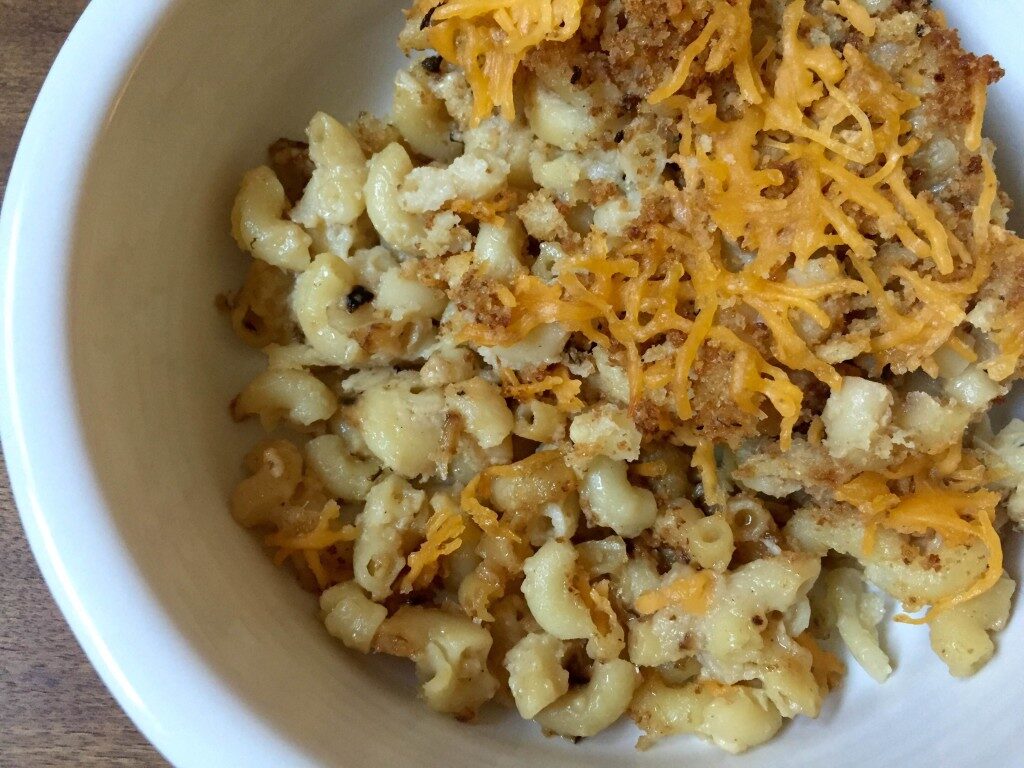 Fennel mac and cheese is never a bad idea. Photo and recipe by Megan Winfrey.
Fennel mac and cheese is never a bad idea. Photo and recipe by Megan Winfrey.






 0 ITEMS IN CART
0 ITEMS IN CART 

